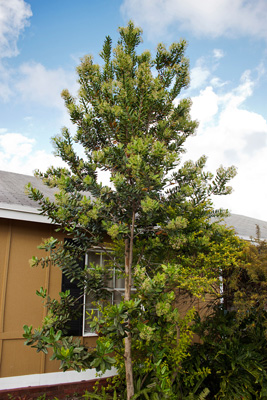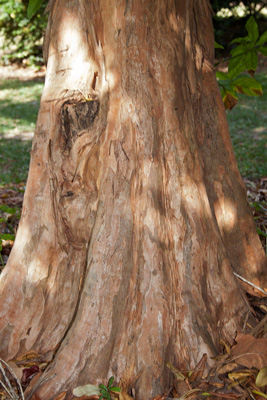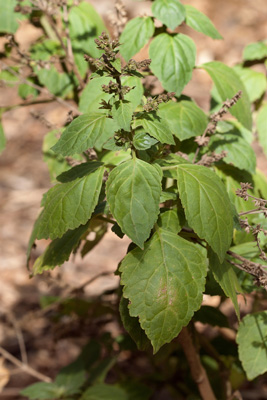Why wait for the flowers to scent your garden? There are plants with foliage that rival the scent of any bloom, and they last a lot longer than the ephemeral flower.
My favorite has got to be the bay rum tree (Pimenta racemosa), sometimes called West Indian bay (not to be confused with bay laurel, Laurus nobilis). It indeed supplies the main ingredient used in the classic bay rum aftershave your grandpa might’ve used. I use it sometimes as well.
Its scent is reminiscent of the old Caribbean — rum, woody, quite spicy with cinnamon and a hint of vanilla and citrus. If gentlemanly adventure had a scent, it would be bay rum. The foliage of the bay rum tree smells as wonderful, or better, than the aftershave.
Bay rum will grow to about 25 to 30 feet tall, and keeps a nice cylindrical, columnar profile. With a small footprint, it fits in well in a small yard. Or you can trim it to keep it shorter and bushier.

Bay rum tree can be kept columnar to take up less horizontal space. Kenneth Setzer/FTBG.
Being native to the Caribbean, once established it can thrive in our region with some benign neglect.
It needs bright sun and summer rains, and we sure have that in the Southeast. Mine grows in a rocky, bright spot in full sunlight. It has grown quickly but doesn’t get out of control. The bark is splotched in shades of beige and gray, and is self-exfoliating. So when the bark starts to peel, do not fret! Your tree is fine.

Peeling bark of the allspice and bay rum trees is normal. Kenneth Setzer/FTBG.
The bay rum tree produces small clusters of white flowers, and fruits in small green globes that mature to purple and black. But it’s the elongate, glossy green leaves that carry the intoxicating smell when rubbed, and especially when crushed. You can pick and break up a few and use them to scent your home just like potpourri. Better still, search online for the many bay rum formulas to use them in. Or throw some in hot bath water.

Bay rum: Its glossy leaves carry an intoxicating scent. Kenneth Setzer/FTBG.
In the same genus as bay rum is allspice (Pimenta dioica). The dried fruit of this tree, when ground, creates the allspice used in cooking. It is an essential part of Jamaican cuisine. The tree appears in most ways very similar to bay rum; Allspice leaves may be a little more puckered, and to my nose smell a little medicinal compared to the richness of bay rum.
Allspice and bay rum are in the Myrtaceae family, along with many stoppers and other aromatic trees. There is definitely a strong family resemblance among them, especially in their mottled bark.
Unrelated to the others is patchouli (Pogostemon heyneanus), but if you’re looking for fragrant foliage, this is the epitome. I fell in love with the heady allure of patchouli in the Greenwich Village of the ’80s, long after its hippie heyday. But it’s as beguiling today as ever.
Native to tropical Asia, patchouli grows well in South Florida as a potted plant. It’s a bushy grower, and can get leggy, so prune it regularly to encourage it to produce denser foliage. Even better is to propagate it from cuttings placed in soil or pure perlite. Just keep it moist and place the cutting in a windowsill. In a couple weeks, it should root.

Patchouli plant: Native to tropical Asia, patchouli grows well in South Florida as a potted plant. Kenneth Setzer/FTBG.
Look for new leaf growth on your cutting, which means you have a new little plant. If you used perlite, remove the cutting and plant it in soil. You’ll smell patchouli if you simply pass by the plant, but if you want to get really involved, look into extracting the oils from the patchouli leaves.
At Fairchild, as well as with my plant at home, the patchouli is placed with an eastern exposure to provide early light while avoiding the scorching midday sun. It likes lots of water, but has tolerated a little wilting if I follow up with a thorough watering. Patchouli is supposedly effective as an insect repellant.
Mine has flowered. The flowers are tiny and white, and believe it or not, they smell a little overbearing, unpleasant even; the leaves are where it’s at.
